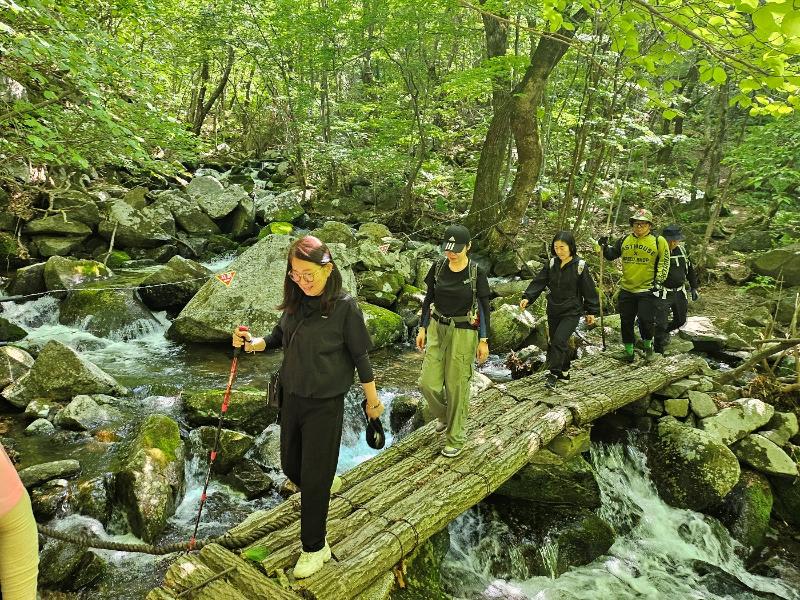
Visitors to the forest DMZ Punch Bowl Dulle Trail in Yanggu-gun County, Gangwon-do Province, cross a valley stream.
By Yoo Yeon Gyeong
Photos = Korea Forest Service
A forest is teeming with life, always embracing organisms to rest body and mind exhausted from the daily grind. As the climate crisis worsens, the importance of forests is amplified as habitats for ecosystems and carbon sink.
To mark the 50th anniversary of national reforestation efforts last year, the Korea Forest Service compiled a list of 100 premium forests in three categories: properly managed, good for recreation and having high preservation value.
Of the 100, Korea.net suggests the following four that are ideal for visiting in July and August. They offer a fresh forest scent and phytoncide, an organic compound emitted from trees often used in aromatherapy and holistic medicine, to heal body and soul and provide relief from the scorching heat.
1. Saryeoni Oreum Forest Path in Seogwipo, Jeju Island
Saryeoni Oreum Forest Path in Seogwipo, Jeju Island
The term “Saryeoni” means “holy” in Jeju dialect. Filled with a light fragrance, this forest is so deep that humans find it hard to approach it.
Saryeoni Oreum (volcanic cone) Forest Path begins at the end of Saryeoni Forest Path as the highest and steepest among the surrounding volcano cones.
This forest has six kinds of needleleaf trees — cedar, black pine, sun tree, pine tree, yew and torreyah — 35 types of broadleaf trees and 19 of evergreen broad-leaved trees. Recognized for its excellent ecosystem, the area in 2002 was designated a UNESCO Biosphere Reserve.
Studies at Hannam Experimental Forest on sustainable forest management and species in subtropical and warm temperature regions are underway by the Warm Temperate and Subtropical Forest Research Center under the National Institute of Forest Science.
DMZ Punch Bowl Forest in Yanggu-gun County, Gangwon-do Province
DMZ Punch Bowl Forest in Yanggu-gun County, Gangwon-do Province
This forest got its name when an American correspondent covering Korean War in 1950 yelled that the sunset-colored basin area looked like a punch bowl when seen from Gachilgong Peak.
This forest is part of the Demilitarized Zone (DMZ), so its rare species and natural forests are well preserved. Rare plant species there include Korean necklace pod, Geumgang bellflower, beautiful wolf’s lilac and sanicula-leaf golden lace as well as endangered wild goats.
The dulle (circumference) path of the forest comprises four hiking courses — Forest Path of Peace (14 km), Oyubat-gil Course (21.1 km), Mandae Field Road (21.9 km) and Munmet Jaegil (16.2 km). This national security-themed tour also offers the nearby attractions of the 4th (underground) Tunnel and Eulji Observatory.
3. Gwangneung Forest in Pocheon, Gyeonggi-do Province
Gwangneung Forest in Pocheon, Gyeonggi-do Province
Gwangneung Forest in Pocheon, Gyeonggi-do Province, is considered a treasure trove of biodiversity.
Since its designation in 1468 as a neunglim, or a forest attached to a royal tomb, by Joseon Dynasty King Sejo, the area has been preserved without damage for 556 years. In June 2010, it was designated a UNESCO Biosphere Reserve.
The forest has a combined 6,251 species of native organisms observed and recorded spanning 3,932 types of insects, 946 plants, 694 higher fungi and 187 birds.
It also has high academic value because the forest’s growth process has been well preserved. Studies underway in the area include biodiversity listing, restoration of nature at artificial forests and rehabilitation of natural monuments.
4. Gombaeryeong Pass in Inje-gun County, Gangwon-do Province
Gombaeryeong Pass in Inje-gun County, Gangwon-do Province
Gombaeryeong Pass spans some 165,000 square m at 1,164 m above sea level. It got its name from the mountain’s shape resembling a bear lying down with its belly facing the sky, and its nickname “Heavenly Garden” stems from the diversity of wild flowers blooming there in spring, summer and fall.
The biodiversity in this area is so high that 854 types of plants, or a fifth of all such species on the Korean Peninsula, grow naturally here. The pass is also protected as a UNESCO Biosphere Reserve and forest genetic resource reserve of the Korea Forest Service.
Visitors in summer can also enjoy wild flower colonies of orange campion, false goat’s beard and impatiens textori and those of kalimeris, stemless gentian and wolfsbane in fall.
dusrud21@korea.kr























